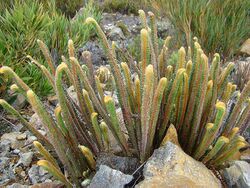Biology:Jamesonia
| Jamesonia | |
|---|---|

| |
| Jamesonia alstonii in habitat, Cerro de la Muerte, Costa Rica | |
| Scientific classification | |
| Kingdom: | Plantae |
| Clade: | Tracheophytes |
| Division: | Polypodiophyta |
| Class: | Polypodiopsida |
| Order: | Polypodiales |
| Family: | Pteridaceae |
| Subfamily: | Pteridoideae |
| Genus: | Jamesonia Hook. & Grev. |
| Type species | |
| Jamesonia pulchra Hook. & Grev.
| |
| Species | |
|
See text. | |
| Synonyms[1] | |
| |
Jamesonia is a genus of ferns in the subfamily Pteridoideae of the family Pteridaceae. It now includes the formerly separate genus Eriosorus.[1]
Description
Species of Jamesonia are terrestrial or grow on rocks. They vary considerably in their detailed morphology. The rhizomes are short, dark brown, and creeping, with a more or less dense covering of hairs and bristles. The fertile and infertile fronds are similar. Species show one of two different frond morphologies, related to habitat. These were formerly used to distinguish Jamesonia and Eriosorus,[2] but do not correspond to the evolutionary history of the species.[3] Species with "Jamesonia-type" morphology have many fronds with short, often leathery pinnae, and are associated with exposed habitats. Species with "Eriosorus-type" morphology have fewer fronds with longer, thinner pinnae, and are associated with more sheltered areas including cloud forests. The stalks (petioles and rachises) of the frond are dark brown and usually grooved on the upper (adaxial) surface. The sori occur along the veins of the segments of the fronds or are sometimes spread more widely on the lower (abaxial) surface of the frond.[2]
Taxonomy
The genus Jamesonia was first described by William Jackson Hooker and Robert Kaye Greville in 1830, initially with one species, Jamesonia pulchra. The genus name of Jamesonia was in honour of William Jameson (1796–1873), who was a Scottish-Ecuadorian botanist.[4] The genus Eriosorus, proposed by Antoine Fée in 1852, was recognized as closely related, both genera being placed in the taenitidoid group of the subfamily Pteridoideae. A molecular phylogenetic study in 2004 showed that neither genus was monophyletic on its own, but that together they formed a clade.[3] Subsequent classifications have treated the two as a single genus, Jamesonia.[5][1] A further study in 2015 showed that the genus Nephopteris with the sole species N. maxonii belonged in the same clade.[6] It is now also included in Jamesonia.[1]
Phylogeny
Within the subfamily Pteridoideae, Jamesonia forms a clade with five other genera, the so-called "JAPSTT" clade, which is one of four major clades within the subfamily Pteridoideae identified in a 2017 study.[7]
| External phylogeny[7] | Internal phylogeny[8][9] | ||||||||||||||||||||||||||||||||||||||||||||||||||||||||||||||||||||||||||||||||||||||||||||||||||||||||||||||||||||||||||||||||||||||||||||||||||||||||||||||||||||||||||||||||||||||||||||||||||||||||||||||||||||||||
|---|---|---|---|---|---|---|---|---|---|---|---|---|---|---|---|---|---|---|---|---|---|---|---|---|---|---|---|---|---|---|---|---|---|---|---|---|---|---|---|---|---|---|---|---|---|---|---|---|---|---|---|---|---|---|---|---|---|---|---|---|---|---|---|---|---|---|---|---|---|---|---|---|---|---|---|---|---|---|---|---|---|---|---|---|---|---|---|---|---|---|---|---|---|---|---|---|---|---|---|---|---|---|---|---|---|---|---|---|---|---|---|---|---|---|---|---|---|---|---|---|---|---|---|---|---|---|---|---|---|---|---|---|---|---|---|---|---|---|---|---|---|---|---|---|---|---|---|---|---|---|---|---|---|---|---|---|---|---|---|---|---|---|---|---|---|---|---|---|---|---|---|---|---|---|---|---|---|---|---|---|---|---|---|---|---|---|---|---|---|---|---|---|---|---|---|---|---|---|---|---|---|---|---|---|---|---|---|---|---|---|---|---|---|---|---|---|---|
|
|
Other species:
- Jamesonia accrescens (A.F.Tryon) Christenh.
- Jamesonia angusta (M.Kessler & A.R.Sm.) Christenh.
- Jamesonia ascendens (A.R.Sm. & M.Kessler) Christenh.
- Jamesonia aureonitens (Hook.) Christenh.
- Jamesonia auriculata A.F.Tryon
- Jamesonia biardii (Fée) Christenh.
- Jamesonia boliviensis A.F.Tryon
- Jamesonia caracasana (Baker) Christenh.
- Jamesonia ceracea Maxon
- Jamesonia chiapensis (Maxon) Christenh.
- Jamesonia crespiana Bosco
- Jamesonia ewanii (A.F.Tryon) Christenh.
- Jamesonia feei (Copel.) Christenh.
- Jamesonia flabellata (Hook. & Grev.) Christenh.
- Jamesonia glaberrima (Maxon) Christenh.
- Jamesonia glaziovii (C.Chr.) Christenh.
- Jamesonia lechleri (Kuhn) Christenh.
- Jamesonia madidiensis (M.Kessler & A.R.Sm.) Christenh.
- Jamesonia mathewsii (Hook.) Christenh.
- Jamesonia orbignyana (Kuhn) Christenh.
- Jamesonia paucifolia (A.C.Sm.) Christenh.
- Jamesonia robusta H.Karst.
- Jamesonia scalaris Kunze
- Jamesonia stuebelii (Hieron.) Christenh.
- Jamesonia vellea (A.F.Tryon) Christenh.
- Jamesonia wurdackii (A.F.Tryon) Christenh.
References
- ↑ 1.0 1.1 1.2 1.3 PPG I (2016), "A community-derived classification for extant lycophytes and ferns", Journal of Systematics and Evolution 54 (6): 563–603, doi:10.1111/jse.12229
- ↑ 2.0 2.1 Della, Aline Possamai; Prado, Jefferson (2020), "Jamesonia (Pteridaceae) in Brazil", Biota Neotropica 20 (2): e20200986, doi:10.1590/1676-0611-bn-2020-0986
- ↑ 3.0 3.1 Sánchez-Baracaldo, Patricia (2004). "Phylogenetics and biogeography of the neotropical fern genera Jamesonia and Eriosorus (Pteridaceae)". American Journal of Botany 91 (2): 274–284. doi:10.3732/ajb.91.2.274. PMID 21653383.
- ↑ Burkhardt, Lotte (2022) (in German) (pdf). Eine Enzyklopädie zu eponymischen Pflanzennamen. Berlin: Botanic Garden and Botanical Museum, Freie Universität Berlin. doi:10.3372/epolist2022. ISBN 978-3-946292-41-8. https://doi.org/10.3372/epolist2022. Retrieved January 27, 2022.
- ↑ Christenhusz, Maarten J. M.; Zhang, Xian-Chun; Schneider, Harald (2011). "A linear sequence of extant families and genera of lycophytes and ferns". Phytotaxa 19 (1): 7. doi:10.11646/phytotaxa.19.1.2. ISSN 1179-3163.
- ↑ Pabón-Mora, Natalia; González, Favio (2015), "Nephopteris out of the clouds: Molecular evidence places the enigmatic N. maxonii (Pteridaceae) within the Jamesoniaclade", Brittonia 68: 83–92, doi:10.1007/s12228-015-9394-0
- ↑ 7.0 7.1 Zhang, Liang; Zhou, Xin-Mao; Lu, Ngan Thi; Zhang, Li-Bing (2017), "Phylogeny of the fern subfamily Pteridoideae (Pteridaceae; Pteridophyta), with the description of a new genus: Gastoniella", Molecular Phylogenetics and Evolution 109: 59–72, doi:10.1016/j.ympev.2016.12.037, PMID 28049040
- ↑ Nitta, Joel H.Expression error: Unrecognized word "et". (2022). "An Open and Continuously Updated Fern Tree of Life". Frontiers in Plant Science 13: 909768. doi:10.3389/fpls.2022.909768. PMID 36092417.
- ↑ "Tree viewer: interactive visualization of FTOL". 2023. https://fernphy.github.io/viewer.html.
Bibliography
- Pichi-Sermolli, Rodolfo E. G. (1977). "Fragmenta Pteridologiae—VI". Webbia 31 (1): 242. doi:10.1080/00837792.1977.10670073. ISSN 0083-7792.
- Schuettpelz, Eric; Schneider, Harald; Huiet, Layne; Windham, Michael D.; Pryer, Kathleen M. (2007). "A molecular phylogeny of the fern family Pteridaceae: Assessing overall relationships and the affinities of previously unsampled genera". Molecular Phylogenetics and Evolution 44 (3): 1172–1185. doi:10.1016/j.ympev.2007.04.011. ISSN 1055-7903. PMID 17570688. http://www.pryerlab.net/publication/fichier1047.pdf.
- Tryon, Alice F. (1970). "A monograph of the fern genus Eriosorus". Contributions from the Gray Herbarium of Harvard University 200 (200): 54–174. doi:10.5962/p.336423.
Wikidata ☰ Q2472635 entry
 |


